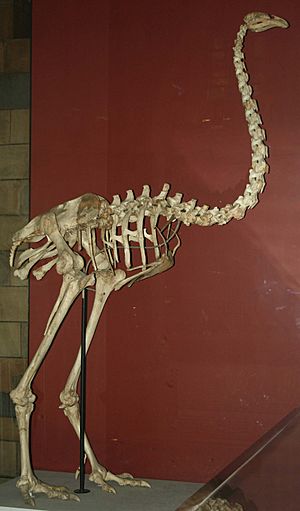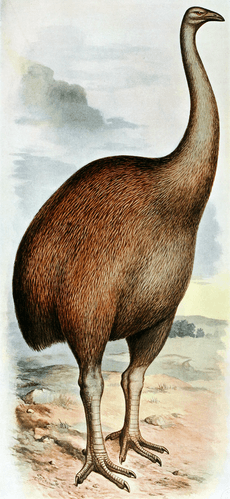North Island giant moa facts for kids
Quick facts for kids North Island giant moaTemporal range: Late Pleistocene- Holocene
|
|
|---|---|
 |
|
| Skeleton, Natural History Museum of London | |
| Conservation status | |
| Scientific classification | |
| Genus: |
Dinornis
|
| Species: |
novaezealandiae
|
The North Island giant moa (Dinornis novaezealandiae) was an amazing, giant bird that used to live in New Zealand. It was one of two types of moa in the Dinornis group. Sadly, this incredible bird is now extinct, meaning it no longer exists anywhere in the world.
About the North Island Giant Moa
The North Island giant moa was a type of bird called a ratite. Ratites are special because they are flightless birds, meaning they cannot fly. Other famous ratites include ostriches, emus, and kiwis.
Moa birds, including the North Island giant moa, belonged to an ancient group called Dinornithiformes. Unlike most birds, ratites have a flat sternum (breastbone) without a strong ridge, or keel. This keel is what flying birds use to attach their powerful flight muscles. Since moa didn't fly, they didn't need this keel.
Scientists now believe that the very first ancestors of these flightless birds might have been able to fly. They think these early birds flew to southern lands, like New Zealand, and then slowly lost their ability to fly over millions of years.
Where They Lived
The North Island giant moa lived only on the North Island of New Zealand. They preferred to live in the lower areas, which included different kinds of environments. You might have found them in shrublands, open grasslands, sandy dunelands near the coast, and even in forests. These varied habitats provided them with plenty of food and places to live.
Images for kids
See also
 In Spanish: Moa gigante de la isla Norte para niños
In Spanish: Moa gigante de la isla Norte para niños




